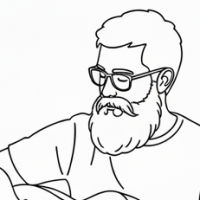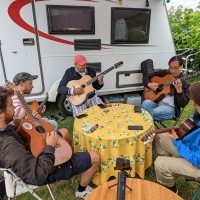DjangoBooks.com
Welcome to our Community!
Categories
- 20K All Categories
- 1.1K General
- 475 Welcome
- 59 Archtop Eddy's Corner
- 146 CD, DVD, and Concert Reviews
- 383 FAQ
- 26 Gypsy Jazz Italia
- 24 Photos
- 202 Gypsy Picking
- 21 Unaccompanied Django
- 15 Pearl Django Play-Along Vol.1
- 17 Gypsy Fire
- 45 Gypsy Rhythm
- 1.4K Gypsy Jazz University - Get Educated
- 130 Gypsy Jazz 101
- 223 Repertoire
- 218 History
- 707 Technique
- 51 Licks and Patterns
- 6 Daniel Givone Manouche Guitare Method Users Group
- 20 Eddie Lang Club
- 1.3K Gypsy Jazz Gear
- 799 Guitars, Strings, Picks, Amps, Pickups and Other Accessories
- 457 Classifieds
- 49 Recording
- 62 Other Instruments
- 18 Violin
- 5 Mandolin
- 22 Accordion
- 7 Bass
- 10 Woodwinds
- 345 Gypsy Jazz Events
- 141 North America
- 109 Europe
- 95 International
In this Discussion
Sound hole in upper side?
 Craig Bumgarner
Drayden, MarylandVirtuoso Bumgarner S/N 001
Craig Bumgarner
Drayden, MarylandVirtuoso Bumgarner S/N 001
Anyone have any experience with a sound hole in the upper side, upper bout, typically oval shaped about the same size as a petite bouche. These were in vogue 5-6 years ago and then faded away. The fade away suggests they may have just been a fade.
The purpose, as I understand it, was to allow the player to hear the guitar better.
I'm getting hard of hearing and I'd like to be able to hear my guitar better when gigging. I have an older guitar that I'd consider experimenting with by cutting in such a hole if the general experience with them was positive. Any down sides? I suppose you could drop things into the hole and would get more dirt inside the guitar. I've seen at least one example where the builder installed a heavy wire mesh screen, like you see on a microphone cover, across the hole from the inside.
Craig
The purpose, as I understand it, was to allow the player to hear the guitar better.
I'm getting hard of hearing and I'd like to be able to hear my guitar better when gigging. I have an older guitar that I'd consider experimenting with by cutting in such a hole if the general experience with them was positive. Any down sides? I suppose you could drop things into the hole and would get more dirt inside the guitar. I've seen at least one example where the builder installed a heavy wire mesh screen, like you see on a microphone cover, across the hole from the inside.
Craig












Comments
"It's a great feeling to be dealing with material which is better than yourself, that you know you can never live up to."
-- Orson Welles
CB
http://mcphersonguitars.com/
Ah, the McPhersons look like the hole in the top is moved to the side. Moving the hole around the top has always been part of the luthier's experiments. There are many variations.
What I'm talking about is a second hole in the side (ribs if your prefer) as well as the hole in the top. Below is a pic of Bob Holo's Shelley Park I copped from Djangobooks from when he was selling it, shows what I have in mind. Are these common today in other guitar styles? In Selmer style guitars at least, this option now seems uncommon. I wonder why?
Craig
http://www.parkguitars.com/q-soundport-effect/
"The effect of a sound port is proportional to the size of the sound hole. The effect on an oval hole can be dramatic, as the net amount of escaping air is almost doubled. This doesn’t seem to compromise the instruments forward projection, the overall volume usually increases.
The effect on a D hole is subtler as the air flow is already maximized by the original design.
In both cases there is noticeable better monitoring for the player, again more pronounced with an oval hole, where there is noticeable air stream displacement from the side port.
On an oval hole model a sound port also allows many of the trapped overtones and lower frequencies to escape, adding sustain and a wide range of color. This effect is harder to detect on a D hole."
New York luthier Bernie Lehmann said essentially the same thing in an article on his versions of Selmer guitars 7-8 years ago. He praised the side hole saying "that cute little hole (meaning the petite bouche hole in the top) is just too darn small to move enough air". The side hole adds more area to openings in the box.
I'm not sure he or Shelley Park actually mean "air" moving through the hole. It seems to me the volume of air displaced by the moving top is minuscule and "air" is not pumping through the hole as the guitar is played at sufficient quantity that even a petite bouche, small oval, would restrict. My guess is they mean more opening area to pass sound waves through the air from the inside to the outside.
CB
soundports, IIRC, were developed by the great robert ruck and provide an excellent means for the player to hear himself in a way similar to the audience, with greater exposure of transients. there´s more to them, though. if you want, give this a read: http://www.alcarruthluthier.com/Downloads/sidePorts.pdf
as for fading away, i don´t know. they are pretty popular in the folk / steel string acoustic guitar scene ATM, and most luthiers offer them at an extra-charge. i´ve even seen a tornavoz installed on a soundport...
on selmer guitars, OTOH, the picture posted is the 1st i´ve seen of a guitar with sideport, but all the geist of the selmer guitar thing seems geared toward the graal of replicating the sound and vintage patine of the older models, wich by virtue of it being a conservative enterprise is by definition less prone to this kind of innovations, but i register the fact with great joy.
cheers,
Miguel.
cheers!